update, Jan 2019: last month we sold this business after owning it for 1 year.
last week my fund acquired Color My Slime, a Shopify store that sells powdered pigments for coloring slime.
there are 43 SKUs; colors cost $1.99 – $5.99, clear slime and starter packs are $9.99 – $24.99.
how it happened
i didn’t go looking for kid toys or adult stress relief products.
instead, i went to Shopify Exchange.
this is a platform for buying and selling ecommerce stores, with a few extras:
- sales / traffic data is verified by Shopify (easy diligence)
- sort by product category, selling price, revenue, etc
- no fees for the buyer or seller (yet)
ever since Exchange launched ~4 months ago, i’ve browsed a couple times per week for the perfect niche business.
how do i define “perfect niche business?”
- organic traffic opportunity, not reliant on paid advertising
- does one thing, and does it really well
- easy-to-understand product
- asset based (NOT drop-shipped) inventory
- proprietary ~ish, not a “me too” commodity
- brand-able
here’s why Color My Slime fits the bill, and what we’re doing next.
driving traffic
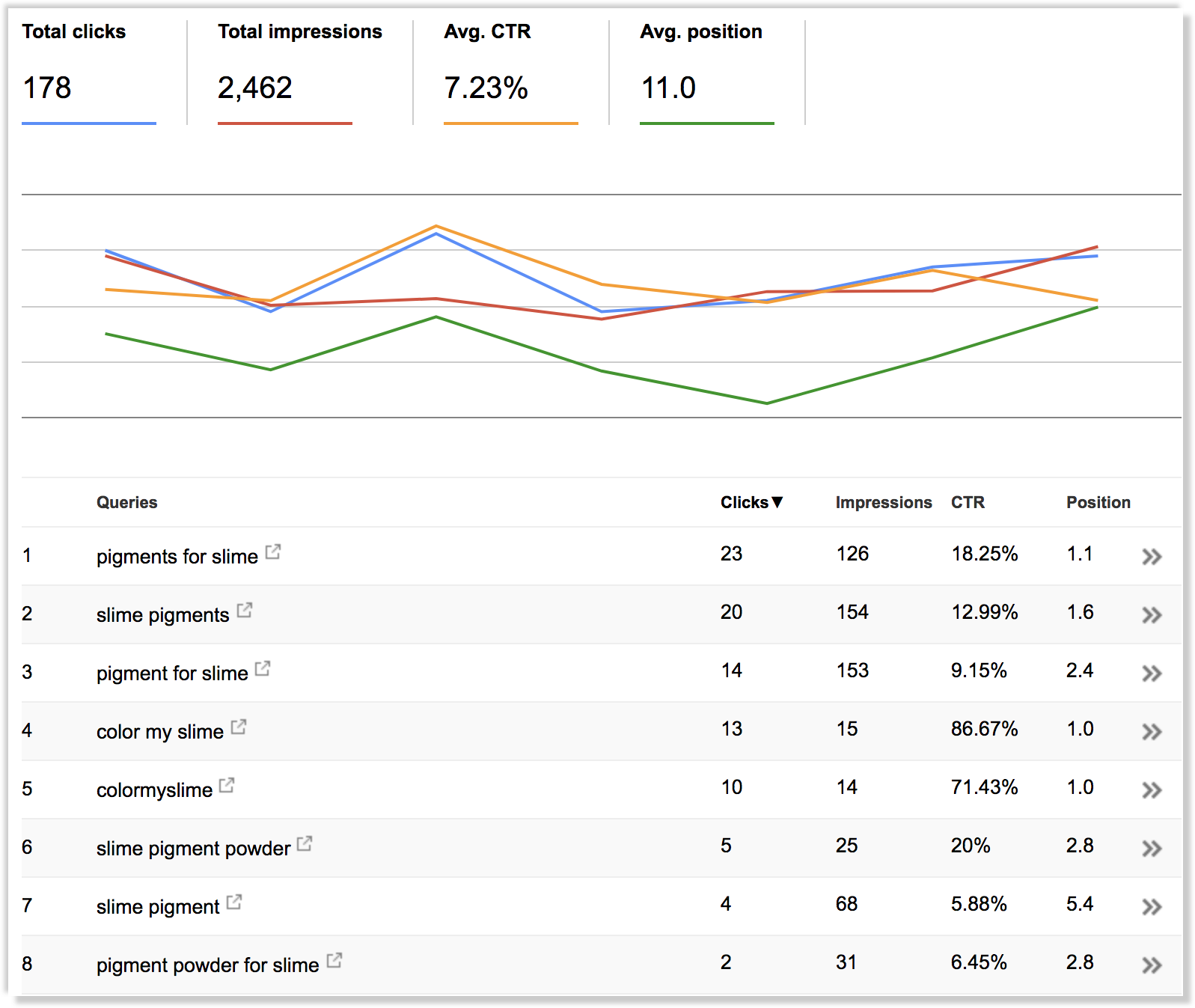
although a new site with few backlinks, Color My Slime already ranks #1-3 for keywords like “slime pigments” and “star flakes” (not depicted).
we also have a growing Instagram account (25,800 followers) that drives more than half our website traffic, 100% free.
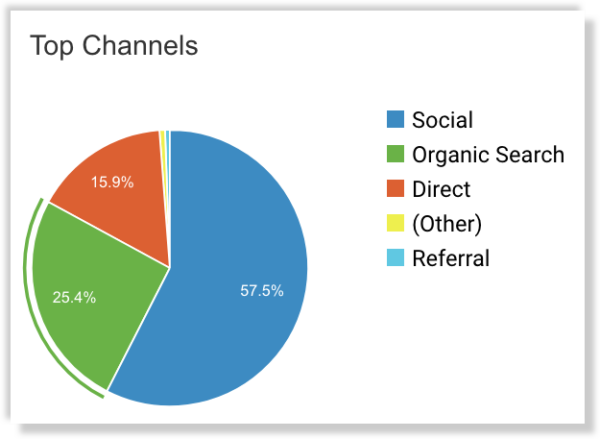
over the next few months we intend to rank for long-tail terms, ie “neon green slime color” or even DIY content like “best way to mix a color into slime.”
i love that Shopify has custom SEO meta editors for title, description, and schema.org conventions like product reviews, inventory quantities, etc.
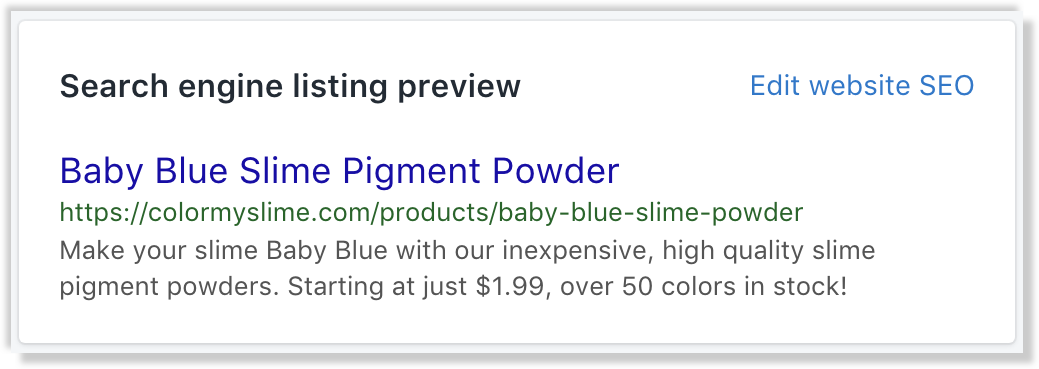
improving conversions
ecommerce success = traffic * conversion rate
here’s the last 30 days’ performance, which includes only 11 20 days of our ownership:
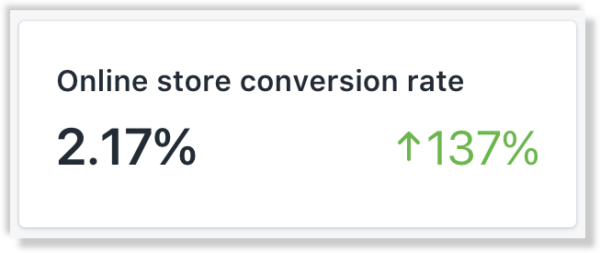
while i’m content with anything above 1.5%, i’d still like to aim for 2.25+ before driving significant traffic through pay-to-play mechanisms like ads or influencers.
any ecommerce entrepreneur will tell you: a 1/10th percent increase in conversion rates can translate to thousands in extra sales, very quickly.
to abet higher conversion rates, we’ve added a few new apps to Color My Slime:
- Fomo (obviously) to show off customer behaviors
- Cross Sell (obviously) to help shoppers find complimentary products
- Judgeme (Yotpo is expensive) to curate product reviews
we also removed a couple apps that annoyed users, like a Facebook Messenger retargeting bot.
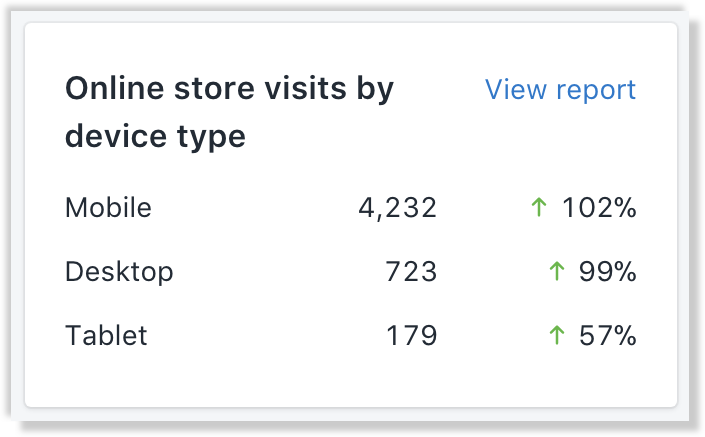
abandoned carts are one of the biggest problem areas for ecommerce stores, and our abandoned cart to checkout ratio is around 50/50.
in other words, only half of the folks who begin checkout, finish.
as we become better acquainted with our target audience – kids – we’re considering solutions like Venmo or Square Cash as payment options, given kids don’t have their own credit cards.
we’re also exploring a new theme, SMS order updates, and Facebook Messenger live support, because younger folks without full-time jobs don’t check email very often, and do most of their shopping on mobile.
defending intellectual property
knowing what i do about technology, margins, customer service, competition, cloning business models… there’s no way i was going to drop-ship a generic widget, mug, or t-shirt.
Color My Slime has an exclusive agreement with a great supplier, which includes guaranteed prices for another 13 months and of course a 2 year non-compete.
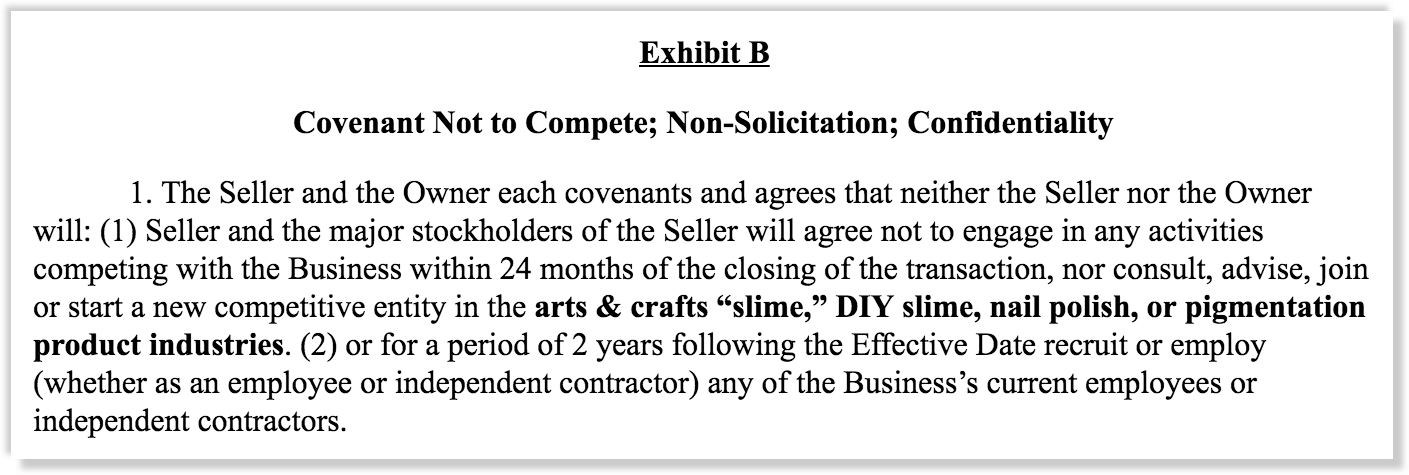
protip: having done 4 acquisition deals in 2017 alone, non-compete clauses are a top 3 most important aspect of asset purchase agreements.
asset based fulfillment
the internet is riddled with “stay at home moms: drop ship and make $5,347 per day!” schemes.
if you can manage to set up a lean workflow, however, it pays to hold inventory.
here’s a small home office we built in our utility closet:
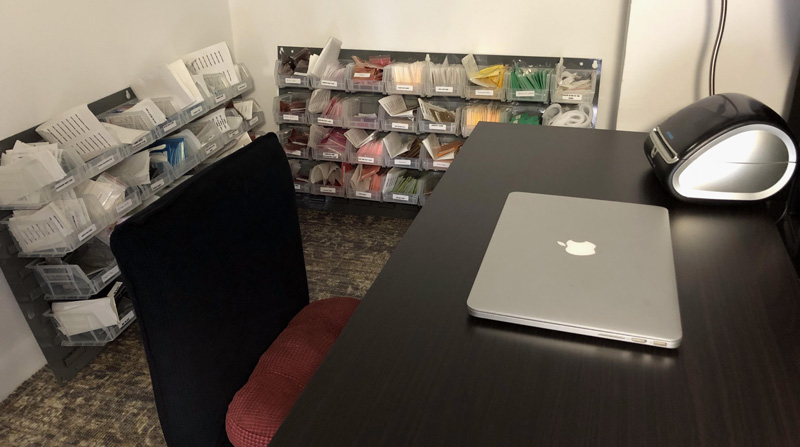
because Color My Slime sells tiny products (5 gram bags of color pigments), we can easily store thousands of dollars in retail value inventory in just a couple boxes under our bed.
holding inventory means we can offer same-day shipping, benefit from wholesale purchase orders (vs on-demand pricing), and profit from our postage rates.
that said, this also means the process of actually fulfilling orders becomes a case study in systems-thinking.
for example, our average package looks like this:
- shipping label
- order slip (invoice w/ items purchased)
- double bagged product
- marketing insert with a sales promotion
- however many colors or slimes a customer purchased
since we have ~50 SKUs, and each pigment is individually packed, a sub-par workflow would destroy our margins, which are currently 47-55%.
to prevent this we built a custom Stock Picker application:
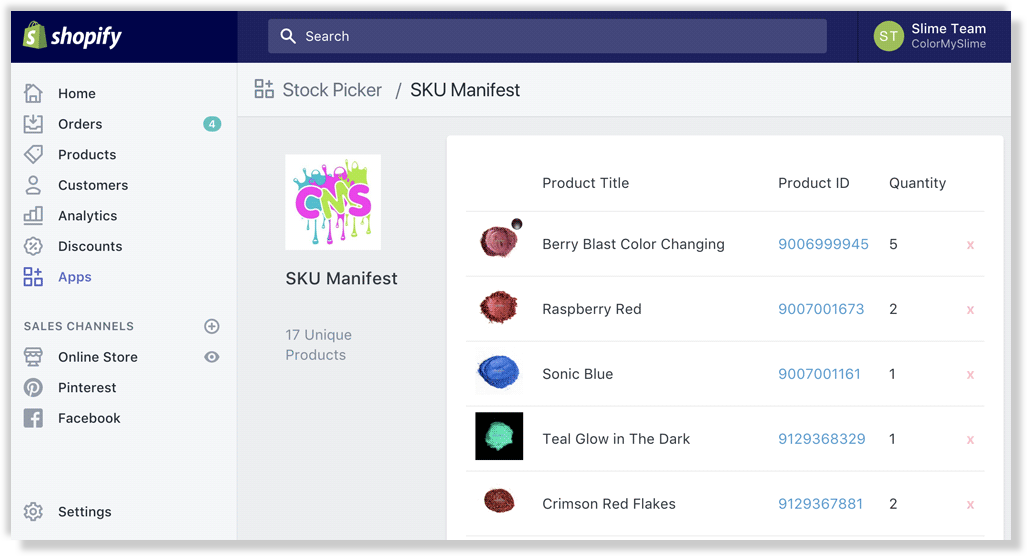
this fetches unfulfilled orders from Shopify and Etsy, normalizes the product IDs, then sums the quantity of each product within that batch of orders.
(Stock Picker does some other cool stuff like syncing inventory every hour between platforms, but i can cover that in a future post).
building a brand
a brand is the gut reaction you have upon hearing a company’s name.
some companies, by the nature of their offering, have less potential to enhance their gut reaction than others.
garbage truck services, for example, elicit “meh” reactions at-best. Red Bull, on the other hand, means “living life on the edge.” Coca-Cola is synonymous with America. and Bitcoin makes me think “San Francisco sucks so bad.”
at Color My Slime we have a huge opportunity to build a brand by following a few key guidelines:
- don’t talk about the product
- cater to non-slimers
- troll safely
slime is… slime. red slime is… red slime.
we don’t need to harp on the product or ingredients, slime is about feeling.
the literal feeling when you physically touch it, and the psychological feeling of satisfaction from the squishy sounds, stress-relief benefits, and so on.
because slime is a simple, fun product, we can build a brand with simple, fun content.
Slime and Smile and have the same letters. :)
for example, we’re rolling out experimental programs for loyal customers like “Slime Time,” a 30 minute window every month with insane deals, new colors, and more.
we’re also launching a blog to help non-slimers discover the space, and recruiting a scientist who can help us test different materials and DIY recipes.
oh, and this is all for fun.
because, slime.
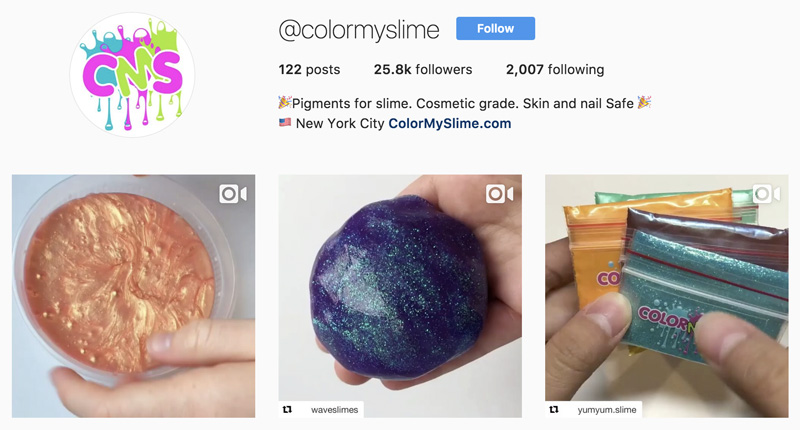
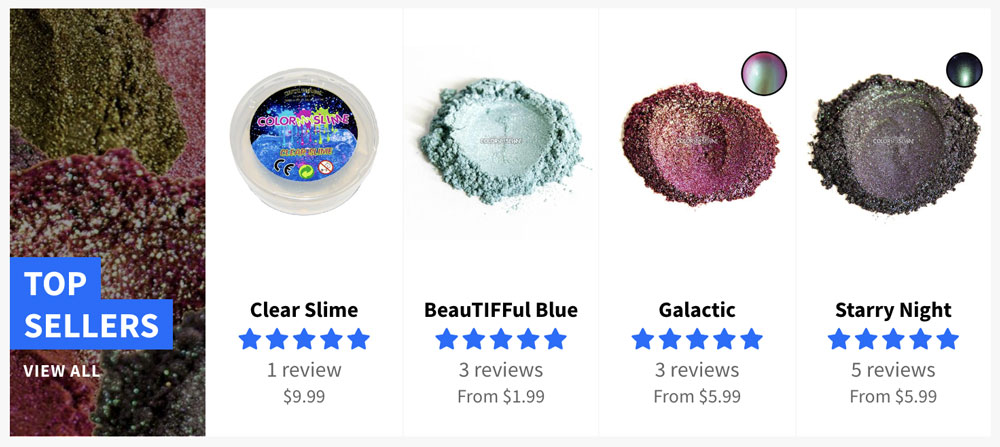
I like the right angle to the marketing. Not buy my slime stuff…
Also like the 30 minute deal window for loyal/current customers.
This seems like a great time to use a Customer Lifecycle Grid to understand the health of the business. Do you use those here or with FOMO?
Color My Slime is a power user of both Fomo and Cross Sell, 2 of our sister companies. ;)
Why did you end up selling the store Ryan? (If it’s something you care to share, of course)
thanks for asking. my wife and i were managing fulfillment personally, then we decided to travel full-time which made that impossible. we investigated a few fulfillment-as-a-service providers but felt the margins would take too large a hit to keep things interesting.
in less timely aspects, a few new competitors emerged and the market size did not get much bigger. seemed like we were burning from both ends of the candle.
I actually assumed since you were traveling that was the case. I remembered you were doing fulfillment on your own. I’m looking for a niche store myself and would like something lime this – small products, easy to store.
Thanks for sharing, Ryan!
What’s your ROI from buying this business to selling this business?
hey Anindya, this deal was not a “win” for us, it was about break-even.
Ryan I’m curious to hear more about the sell and post-mortem. You seem to be pretty good at this, and even had some nice improvements, but even with all of that it ultimately ended up being a break even. With the hassle of going through a buying & selling process, I’d imagine even a slight profit might make it feel not worthwhile.
Not sure if you mean break even including your time and everything else, but I think it does frame the story a little differently. If it didn’t increase in value or cash flow nicely for awhile, why not? Were there warning signs you could have seen leading up to it? Even if it was break even, was it worth doing for other reasons?
All of that being said, thanks for sharing so much in the article, even some of the legalese, it’s awesome to see being the details that happen behind the scenes
hey Aaron,
that’s right. a breakeven is similar to a loss, pending how much fun you had doing it or if there were key learnings you can apply to other projects. by “break even” in this case we mean that our sale price wasn’t better than our “buy” price but we did make profitable every month from the business itself.
as for “why,” i don’t like to pin things on competition per se but within a month of buying the company, at least 2 new competitors came out and they spent a lot of resources on marketing. we choose to go the organic, brand loyalty route, which was fine, until those competitors reduced prices significantly. even a 5-15% difference in price is a big deal in this market since you’re selling to “poor kids” who spend their allowance on slime.
perhaps my course on the subject can help you out further: https://www.microacquisitions.com